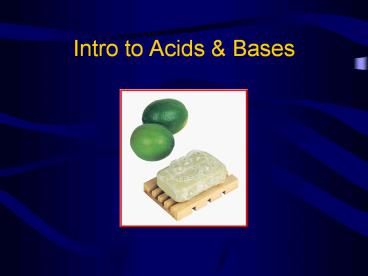Intro to Acids - PowerPoint PPT Presentation
1 / 18
Title: Intro to Acids
1
Intro to Acids Bases
2
Properties of Acids Bases
- Acids
- Taste sour
- Reacts with metals
- Turns litmus red
- Conducts electricity
- Base
- Taste bitter
- Slippery
- Turns litmus blue
- Conducts electricity
3
Ions in Solution
- Acidic solutions contain more H than OH-
- Basic solutions contain more OH- than H
- Neutral solutions contain equal amounts of H
and OH-
4
Autoionization of Water
- H2O H2O ? H3O OH-
- Water is the usual solvent for acids and bases
- It produces equal numbers of H3O and OH-
5
Arrhenius Model of Acids Bases
- Acid a substance that contains H and ionized to
produce H when dissolved in water. - Base a substance that contains OH and ionizes to
produce OH- when dissolved in water
6
Arrhenius Model of Acids Bases
- HCl ? H Cl-
- HCl contains H and ionizes to form H
- This could be an Arrhenius acid
- NaOH ? Na OH-
- NaOH contains OH and ionized to form OH-
- This could be considered an Arrhenius base
7
Arrhenius Model of Acids Bases
- Although the Arrhenius model is useful in
describing many acids and bases, it does not
describe them all - For example NH3 contains no OH- ions, but it is a
base - A model to describe all bases is needed
8
Bronsted-Lowry Model
- Acid proton donor
- Base proton acceptor
- HX H20 ? H3O X-
- HX donates an H to the water molecule
- The water takes the H and is there for considered
the base
9
Bronsted-Lowry Model
- Conjugate acid the species produced when a base
accepts the H ion from the acid - Conjugate base the species produced when the
acid gives up its H
10
Conjugate Acids Conjugate Bases
- Identify the acid, base, conjugate acid, and
conjugate base of the following reaction - HX H20 ? H3O X-
- A B CA CB
- Every Bronsted-Lowry interaction involves
conjugate acid base pairs
11
Conjugate Acids Conjugate Bases
- Identify the acid, base, conjugate acid, and
conjugate base of the following reaction - NH3 H20 ? NH4 OH-
- B A CA CB
12
Conjugate Acids Conjugate Bases
- What did you notice that was different about the
previous two reactions? - Water was an acid in one and a base in the other
- Amphoteric substance that can act as either an
acid or a base
13
Conjugate Acids Conjugate Bases
- Identify the acid, base, conjugate acid, and
conjugate base of the following reactions - NH4 OH- ? NH3 H20
- A B CB CA
- HBr H2O ? H3O Br -
- A B CA CB
14
The pH Scale
- H is often expressed in very small numbers.
Chemists needed an easier way to express H
ions - pH is a mathematical scale in which the
concentration of hydronium ions in a solution is
expressed as a number from 0 to 14. - pH -logH
15
Interpreting the pH Scale
- pH of 7 is neutral. A pH less than 7 is acidic,
and a pH greater than 7 is basic.
pH pOH 14
16
Acid Strength
- The strength of an acid or a base tells you the
degree of ionization - Strong acids bases break down into many ions
- Weak acids bases break down into just a few ions
17
Neutralization Reactions
- Neutralization reactions acid base ? a salt
water - Neutralization reactions are just a special type
of double replacement reactions
18
Neutralization Reactions
- Write the equations for the following
neutralization reactions - Acetic acid and ammonium hydroxide
- HCH3COO NH4OH ? HOH NH4CH3COO
- Nitric acid and cesium hydroxide
- HNO3 CsOH ? HOH CsNO3































